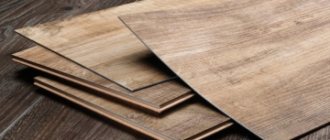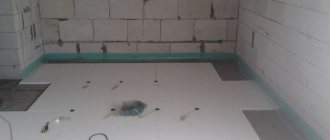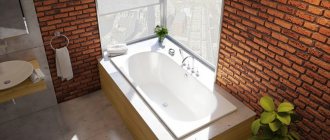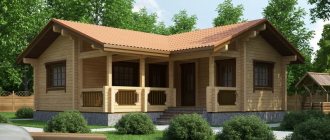Insulating houses has become a necessity, since many structures do not provide the necessary protection from low temperatures. For these purposes, you can use various modern technologies, many of which involve multilayering. However, the use of insulating materials requires a competent approach to preserve their properties. One of the most important points is vapor barrier for internal and external walls. The absence of such a layer during sudden temperature changes can lead to destruction of the fiber structure and further deterioration in the degree of protection of the building from frost and wind.
Why do you need a vapor barrier?
Sometimes questions arise whether a vapor barrier is needed when insulating walls with foam plastic. The answer is clear - it is necessary, since this material does not provide complete removal of condensate from the room. At the same time, the insulation itself is quite fragile, which can negatively affect the thermal insulation of the house.
In many ways, the result of the work depends on the correct installation of the vapor barrier. After all, violation of the sequence of work will lead to the appearance of moisture, which will negatively affect the condition of the building frame.
Why do you need vapor barrier on walls? It prevents the penetration of steam, thereby ensuring the safety of the walls. Condensation usually accumulates in damp areas. It can be removed through the ceiling and walls. If this process is repeated periodically, the structure may begin to collapse.
Where vapor barrier is required
Few novice builders understand how important and why high-quality vapor barrier of walls is needed. In some cases, vapor barrier is a mandatory element during construction. These include the following cases:
- Vapor barrier of walls from the inside when using cotton wool materials as insulation. Cotton wool is a high-quality thermal insulator, but it is susceptible to high humidity. When condensation occurs, they quickly lose their performance properties. Therefore, insulation from moisture in such structures is necessary.
- When creating multilayer structures in frame houses, since condensation may occur between the layers.
- In ventilated facades, the outer walls need vapor barrier protection from the wind. It not only makes the flow softer, but also prevents it from completely reaching the surface. This method allows you to reduce the load on the outer insulating layer, which must be protected with a waterproofing material. It is especially important to organize protection when using siding to insulate the walls of a house.
However, do not forget that in other structures, insulation is also important, it just does not become a serious problem.
The best manufacturers
To purchase high-quality building materials, you need to focus, among other things, on the manufacturer. Choosing a reliable and trusted supplier will help you avoid possible problems. Let's look at the two most famous ones.
Types of vapor barrier materials
The material for wall insulation is selected for a specific object and its design features. Therefore, talking about universal options is biased.
In the range of options offered, you can choose either rolled or liquid materials. They differ in composition and purpose:
- mastic is a bitumen-polymer base that is applied to surfaces, creating a protective layer. It is used for wooden, brick and concrete buildings. It is recommended to apply it in two layers to dry surfaces. The advantage of this material is the ability to use it immediately after purchase. The service life of such an insulating layer reaches 25 years while maintaining its vapor barrier functions;
- membranes have a number of advantages over other materials: they protect external walls and go well with clapboard or siding. The main condition for installing such a film is a tight fit to the insulation and its reliable fixation. The most popular membrane options: Izospan FD, FS, FX (used in saunas, baths and bathrooms) and “Megaizol B” with an “anti-condensation” surface. They are produced for various purposes, so it is important to pay attention to this factor when purchasing. Izospan is usually used for interior wall decoration;
- vapor barrier film of minimal thickness (less than 0.1 mm) is considered the most popular, since it is not perforated and does not allow air to pass through. It is suitable for organizing micro-ventilation of walls and insulating material, for partial removal of condensate and for creating a vapor barrier in damp rooms;
- Liquid rubber is produced in the form of a bitumen-polymer product that creates a covering that exactly follows the surface topography. It does not allow moisture to pass through, but provides hydro- and thermal insulation. There are several types of liquid rubber: emulsion for application by machine (usually used on the floor) and for manual application. These are materials used to protect the foundation from the street.
The choice of materials is huge, so it is up to the owner to decide which vapor barrier to choose for the walls of a brick or frame house, inside and out.
How steam is formed
The peculiarities of the climate of our latitudes force people to maintain a temperature in their living quarters higher than outside for a significant part of the year. The density of cold air is greater than that of warm air, so with such a difference, excess moisture settles in the form of condensation on the elements of the house.
Even more ideas for building private houses can be found on the website: https://masterinterera.ru/doma/
Features of vapor barrier installation
Many people are interested in how to properly lay vapor barrier film. In this case, it is enough to strictly follow the instructions for performing work on various sections of the construction site.
How to lay a vapor barrier layer on walls
As a result of installing the vapor barrier film, a layer consisting of several elements should appear. The new building cake should consist of several layers:
- external cladding;
- windproofing;
- insulation layer;
- frame;
- vapor barriers;
- interior decoration.
Before you finally lay the vapor barrier, you should decide on its purpose. To ventilate the insulation, materials are installed only on internal walls. In this case, the insulator cannot be fixed on both sides of the insulation, as this will lead to the formation of condensation due to disruption of the natural insulation.
If mineral-based materials were chosen as insulation, laying a vapor barrier layer is required. It is also important how to install the vapor barrier. Compliance with the work order guarantees high quality and long service life. The process consists of several stages:
- Installing the film and securing it to the sheathing.
- Sealing formed cracks, overlaps and puncture sites.
- Installation of sheathing using beams to provide ventilation.
- Sheathing with plasterboard, panels or other finishing materials.
However, it is impossible to install vapor barriers on walls without pre-treatment.
Preparatory work
Before installing the insulating layer, you should select a material taking into account the characteristics of its installation process. For example, when working in a wooden house, all materials must undergo protective treatment with antiseptic agents and fire retardants.
Before attaching the vapor barrier to the insulation layer of the internal walls, dismantling work should be carried out to clean the surfaces from the remnants of previous finishing materials. Cleaned natural wood surfaces are treated with compounds to prevent burning and rotting. Concrete or block buildings should also be treated with a deep penetration antiseptic compound.
When insulating brick walls from the outside, it is recommended to carefully eliminate all cracks and cracks. And after this, treat the surfaces with an antiseptic solution. Only on completely cleaned surfaces can leveling mixtures be applied and a vapor barrier coating system installed.
Ceiling vapor barrier
For the ceiling, you can also use materials with foil surfaces. They are laid with the heat-reflecting side inside the room for better heat retention. Fastenings are made using nails with wide heads, and the joints are additionally insulated with tape.
It is necessary to lay a layer of vapor barrier on the ceiling on laid layers or rolls of insulation, previously laid in the spaces between the joists and rafters. If the thickness of such insulation is equal to the height of the logs, it may be necessary to install a slatted counter-lattice to maintain a constant level of ventilation. In this case, you need to fasten it correctly: with a slight overlap on the walls around the perimeter. Particular attention should be paid to the corners: we fix the film with an overlap and tightly.
Roof vapor barrier
It is better to choose a membrane film for the roof. How to properly install such a vapor barrier? Place the smooth side on the insulation. To prevent steam particles from penetrating through the mounting holes, it is recommended to fasten the insulation directly to the wooden beams with a staple gun. This ensures the tightest possible fit. Therefore, perforated films are not used for vapor barrier of roofs and ceilings.
There are films with an anti-condensation coating that are placed under materials susceptible to rust (galvanized steel, corrugated sheets or metal tiles). This film can protect metal surfaces from moisture droplets. Such materials are laid with the fabric side down at a short distance from the layer of mineral wool or any other insulation. It is possible to lay two layers of film with anti-condensation treatment.
External vapor barrier of the walls of the house is necessary to combat atmospheric moisture, which can destroy the insulating material. It is important to make a double vapor barrier layer of insulation. This will cover all the joints of the sheets and provide more reliable protection from steam and unnecessary moisture.
Recommendations for vapor barrier of frame structures
It is important to understand that to vapor barrier the walls of a frame house, you first need to install the membrane on the desired side and secure it to the racks using a construction stapler. The resulting joints should be glued with tape or a layer of mastic.
In some cases, a vapor barrier may not be required for frame walls. This usually happens when using polyurethane foam or ecowool as insulation. However, in this case, high-quality ventilation of the facades must be organized.
If there is still a need, you can use one of the schemes:
- Attaching the barrier film to the frame under plasterboard or clapboard sheathing. This is an option for organizing a vapor barrier for the walls outside of a wooden house for seasonal use: a cottage, a workshop or a guest house.
- Installing a layer of sheathing over the membrane. It creates an air gap between the insulation and the wall. This method is used only for permanent residence buildings, especially in the cold season.
To vapor barrier a house wall from the inside, the second option is used.
If you have doubts whether a vapor barrier is needed under the lining inside the house, it is better to play it safe and install it.
Izospan
A domestic manufacturer whose products meet all international standards. Produces 3 types of products:
Izospan C. Two-layer film, one side of which is slightly rough. It retains excess moisture, facilitating its effective evaporation. It is laid on the other side, which is smoother. Well suited as a vapor barrier for roofing.
Izospan B. Differs from the previous one in that it is more suitable for protecting walls.
Izospan D. Universal film equipped with an anti-condensation coating. It has increased strength, thanks to which it can be used as a temporary roof and cladding of external walls.
Vapor barrier of walls in wooden houses
Wood is a capricious material, so it needs special vapor protection. During the first five years, there is a gradual shrinkage of the walls, the formation of cracks, a change in the size of the logs, and a change in the shape of the logs.
Compared to houses made of concrete and brick, wooden ones are characterized by a higher vapor permeability rate. It depends on the thickness of the timber used for the construction of the building, as well as on the quality of the grooves and existing defects on the surfaces (cracks and crevices). Therefore, when organizing a vapor barrier for walls outside a wooden private house, it is necessary to follow certain rules:
- Glued laminated timber should be dried as best as possible before use.
- The timber should have sealing grooves to minimize the formation of steam.
- When using logs without preliminary drying, finishing work is not carried out for 5 years, since this is the time required for the tree to change its parameters and lose its tightness. With this construction method, you can use membranes such as “Izospan B”, “Izospan FB”, “Izospan FS”.
Following simple rules for installing vapor barriers and interior finishing of walls and ceilings will help avoid problems in future operation. Moreover, the duration of use of such a protective system can be equal to the service life of the entire building. The main thing is that the materials used are not only of good quality, but also correctly installed on the insulating layer.
Membrane films
The base of the vapor barrier membrane is polypropylene, with fiberglass mesh. The rough surface of the film creates a barrier that does not allow moisture to pass into both the wall and the insulation.
Due to the fact that the membrane is multi-layered, it stops not only the permeability of moisture, but also allows a small amount of air to pass inside.
Advantages:
- Can be used for wooden and frame houses;
- No need to create an air gap;
- Easy installation;
- Strength;
- Resistance to an increase in the number of mold microorganisms on the surface of the walls;
- Resistance to putrefactive processes;
- The material is harmless to humans;
- Extended service life - the film retains the original properties declared by the manufacturers for 50 years;
- Large temperature coverage during operation (from -60 to +80 °C);
- The presence of types of membranes reinforced with a layer of foil, which will reflect the heat coming from the house.











